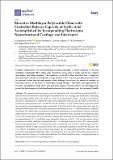Por favor, use este identificador para citar o enlazar a este item:
http://hdl.handle.net/10261/197360COMPARTIR / EXPORTAR:
 SHARE SHARE
 CORE
BASE CORE
BASE
|
|
| Visualizar otros formatos: MARC | Dublin Core | RDF | ORE | MODS | METS | DIDL | DATACITE | |

| Campo DC | Valor | Lengua/Idioma |
|---|---|---|
| dc.contributor.author | Quiles Carrillo, Luis | es_ES |
| dc.contributor.author | Montanes, Néstor | es_ES |
| dc.contributor.author | Lagarón Cabello, José María | es_ES |
| dc.contributor.author | Balart, Rafael | es_ES |
| dc.contributor.author | Torres Giner, Sergio | es_ES |
| dc.date.accessioned | 2020-01-02T11:04:55Z | - |
| dc.date.available | 2020-01-02T11:04:55Z | - |
| dc.date.issued | 2019-02-05 | - |
| dc.identifier.citation | Applied Sciences 9(3): 533 (2019) | es_ES |
| dc.identifier.uri | http://hdl.handle.net/10261/197360 | - |
| dc.description.abstract | The present research reports on the development of bi- and multilayer polylactide (PLA) films by the incorporation of electrospun nanostructured PLA coatings and interlayers containing the antioxidant gallic acid (GA) at 40 wt% onto cast-extruded PLA films. To achieve the bilayer structures, submicron GA-loaded PLA fibers were applied on 200-µm cast PLA films in the form of coatings by electrospinning for 1, 2, and 3 h. For the multilayers, the cast PLA films were first coated on one side by electrospinning, then sandwiched with 10-µm PLA film on the other side, and the resultant whole structure was finally thermally post-treated at 150 °C without pressure. Whereas the bilayer PLA films easily delaminated and lacked transparency, the multilayers showed sufficient adhesion between layers and high transparency for deposition times during electrospinning of up to 2 h. The incorporation of GA positively contributed to delaying the thermal degradation of PLA for approximately 10 °C, as all films were thermally stable up to 345 °C. The in vitro release studies performed in saline medium indicated that the GA released from the bilayer PLA films rapidly increased during the first 5 h of immersion while it stabilized after 45–250 h. Interestingly, the PLA multilayers offered a high sustained release of GA, having the capacity to deliver the bioactive for over 1000 h. In addition, in the whole tested period, the GA released from the PLA films retained most of its antioxidant functionality. Thus, during the first days, the bilayer PLA films can perform as potent vehicles to deliver GA while the multilayer PLA films are able to show a sustained release of the natural antioxidant for extended periods. | es_ES |
| dc.description.sponsorship | This research was supported by the Ministry of Science, Innovation, and Universities (MICIU) program numbers MAT2017-84909-C2-2-R and AGL2015-63855-C2-1-R and by the EU H2020 project YPACK (reference number 773872).L.Q.-C. wants to thank Generalitat Valenciana (GV) for his FPI grant (ACIF/2016/182) and the Spanish Ministry of Education, Culture, and Sports (MECD) for his FPU grant (FPU15/03812). S.T.-G. acknowledges MICIU for his Juan de la Cierva–Incorporación contract (IJCI-2016-29675). | es_ES |
| dc.language.iso | eng | es_ES |
| dc.publisher | Multidisciplinary Digital Publishing Institute | es_ES |
| dc.relation | info:eu-repo/grantAgreement/MINECO/Plan Estatal de Investigación Científica y Técnica y de Innovación 2013-2016/MAT2017-84909-C2-2-R | es_ES |
| dc.relation | info:eu-repo/grantAgreement/MINECO/Plan Estatal de Investigación Científica y Técnica y de Innovación 2013-2016/AGL2015-63855-C2-1-R | es_ES |
| dc.relation | info:eu-repo/grantAgreement/EC/H2020/773872 | es_ES |
| dc.relation.isversionof | Publisher's version | es_ES |
| dc.rights | openAccess | es_ES |
| dc.subject | PLA | es_ES |
| dc.subject | GA | es_ES |
| dc.subject | Electrospinning | es_ES |
| dc.subject | Multilayer films | es_ES |
| dc.subject | Bioactive packaging | es_ES |
| dc.title | Bioactive Multilayer Polylactide Films with Controlled Release Capacity of Gallic Acid Accomplished by Incorporating Electrospun Nanostructured Coatings and Interlayers | es_ES |
| dc.type | artículo | es_ES |
| dc.identifier.doi | 10.3390/app9030533 | - |
| dc.description.peerreviewed | Peer reviewed | es_ES |
| dc.relation.publisherversion | https://doi.org/10.3390/app9030533 | es_ES |
| dc.identifier.e-issn | 2076-3417 | - |
| dc.contributor.funder | Ministerio de Economía y Competitividad (España) | es_ES |
| dc.contributor.funder | European Commission | es_ES |
| dc.contributor.funder | Generalitat Valenciana | es_ES |
| dc.relation.csic | Sí | es_ES |
| oprm.item.hasRevision | no ko 0 false | * |
| dc.identifier.funder | http://dx.doi.org/10.13039/501100003329 | es_ES |
| dc.identifier.funder | http://dx.doi.org/10.13039/501100003359 | es_ES |
| dc.identifier.funder | http://dx.doi.org/10.13039/501100000780 | es_ES |
| dc.type.coar | http://purl.org/coar/resource_type/c_6501 | es_ES |
| item.grantfulltext | open | - |
| item.openairecristype | http://purl.org/coar/resource_type/c_18cf | - |
| item.fulltext | With Fulltext | - |
| item.cerifentitytype | Publications | - |
| item.languageiso639-1 | en | - |
| item.openairetype | artículo | - |
| Aparece en las colecciones: | (IATA) Artículos | |
Ficheros en este ítem:
| Fichero | Descripción | Tamaño | Formato | |
|---|---|---|---|---|
| applsci-09-00533-v2.pdf | Artículo principal | 2,31 MB | Adobe PDF |  Visualizar/Abrir |
CORE Recommender
SCOPUSTM
Citations
53
checked on 26-may-2024
WEB OF SCIENCETM
Citations
49
checked on 28-feb-2024
Page view(s)
183
checked on 28-may-2024
Download(s)
150
checked on 28-may-2024
Google ScholarTM
Check
Altmetric
Altmetric
NOTA: Los ítems de Digital.CSIC están protegidos por copyright, con todos los derechos reservados, a menos que se indique lo contrario.
